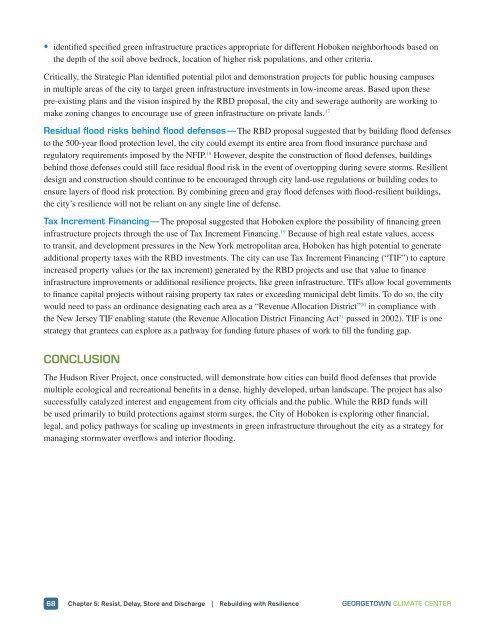Rebuilding with Resilience
dw0r306aHfX
dw0r306aHfX
Create successful ePaper yourself
Turn your PDF publications into a flip-book with our unique Google optimized e-Paper software.
• identified specified green infrastructure practices appropriate for different Hoboken neighborhoods based on<br />
the depth of the soil above bedrock, location of higher risk populations, and other criteria.<br />
Critically, the Strategic Plan identified potential pilot and demonstration projects for public housing campuses<br />
in multiple areas of the city to target green infrastructure investments in low-income areas. Based upon these<br />
pre-existing plans and the vision inspired by the RBD proposal, the city and sewerage authority are working to<br />
make zoning changes to encourage use of green infrastructure on private lands. 17<br />
Residual flood risks behind flood defenses — The RBD proposal suggested that by building flood defenses<br />
to the 500-year flood protection level, the city could exempt its entire area from flood insurance purchase and<br />
regulatory requirements imposed by the NFIP. 18 However, despite the construction of flood defenses, buildings<br />
behind those defenses could still face residual flood risk in the event of overtopping during severe storms. Resilient<br />
design and construction should continue to be encouraged through city land-use regulations or building codes to<br />
ensure layers of flood risk protection. By combining green and gray flood defenses <strong>with</strong> flood-resilient buildings,<br />
the city’s resilience will not be reliant on any single line of defense.<br />
Tax Increment Financing — The proposal suggested that Hoboken explore the possibility of financing green<br />
infrastructure projects through the use of Tax Increment Financing. 19 Because of high real estate values, access<br />
to transit, and development pressures in the New York metropolitan area, Hoboken has high potential to generate<br />
additional property taxes <strong>with</strong> the RBD investments. The city can use Tax Increment Financing (“TIF”) to capture<br />
increased property values (or the tax increment) generated by the RBD projects and use that value to finance<br />
infrastructure improvements or additional resilience projects, like green infrastructure. TIFs allow local governments<br />
to finance capital projects <strong>with</strong>out raising property tax rates or exceeding municipal debt limits. To do so, the city<br />
would need to pass an ordinance designating each area as a “Revenue Allocation District” 20 in compliance <strong>with</strong><br />
the New Jersey TIF enabling statute (the Revenue Allocation District Financing Act 21 passed in 2002). TIF is one<br />
strategy that grantees can explore as a pathway for funding future phases of work to fill the funding gap.<br />
CONCLUSION<br />
The Hudson River Project, once constructed, will demonstrate how cities can build flood defenses that provide<br />
multiple ecological and recreational benefits in a dense, highly developed, urban landscape. The project has also<br />
successfully catalyzed interest and engagement from city officials and the public. While the RBD funds will<br />
be used primarily to build protections against storm surges, the City of Hoboken is exploring other financial,<br />
legal, and policy pathways for scaling up investments in green infrastructure throughout the city as a strategy for<br />
managing stormwater overflows and interior flooding.<br />
68 Chapter 5: Resist, Delay, Store and Discharge | <strong>Rebuilding</strong> <strong>with</strong> <strong>Resilience</strong> GEORGETOWN CLIMATE CENTER


